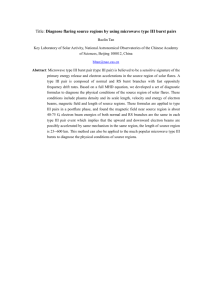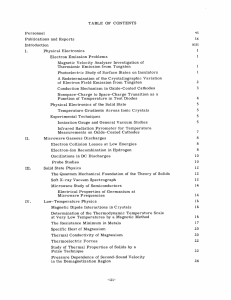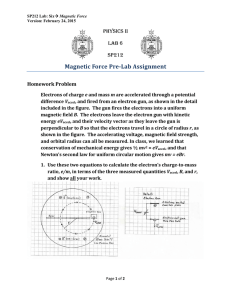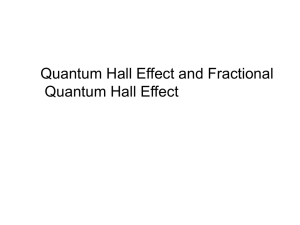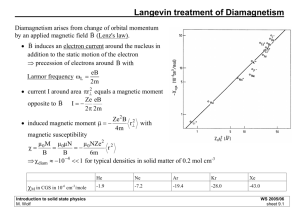II. MICROWAVE GASEOUS DISCHARGES Prof. S. C. Brown B. Lax
advertisement
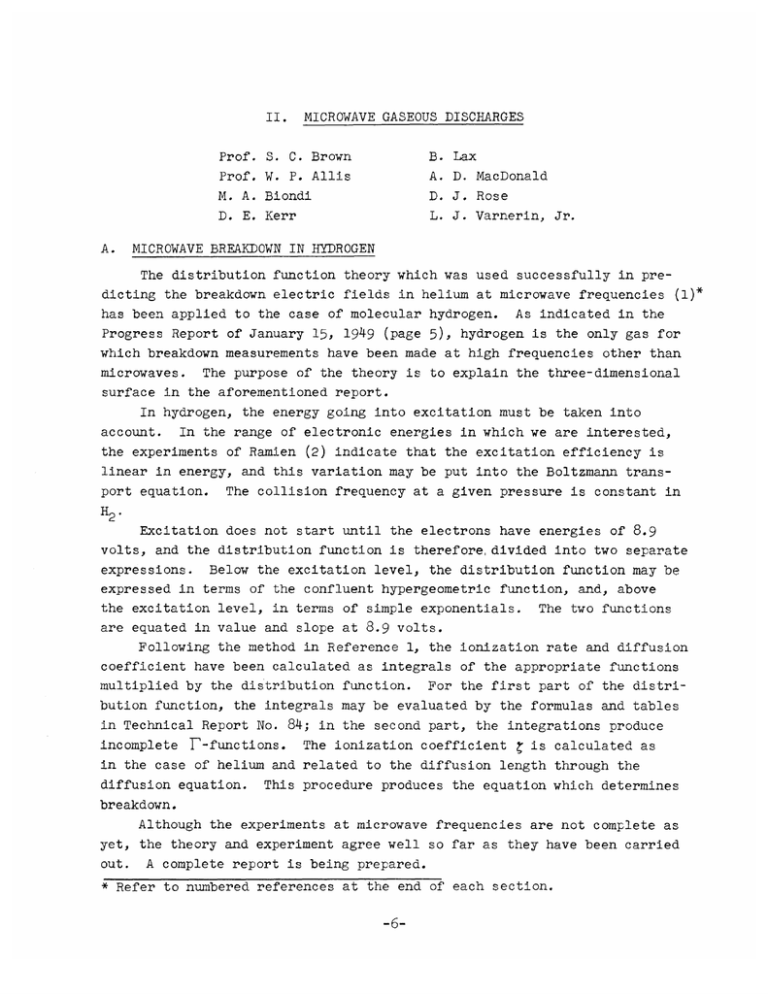
II. A. MICROWAVE GASEOUS DISCHARGES Prof. S. C. Brown B. Lax Prof. W. P. Allis A. D. MacDonald M. A. Biondi D. J. Rose D. E. Kerr L. J. Varnerin, Jr. MICROWAVE BREAKDOWN IN HYDROGEN The distribution function theory which was used successfully in pre- dicting the breakdown electric fields in helium at microwave frequencies (1)* has been applied to the case of molecular hydrogen. As indicated in the Progress Report of January 15, 1949 (page 5), hydrogen is the only gas for which breakdown measurements have been made at high frequencies other than microwaves. The purpose of the theory is to explain the three-dimensional surface in the aforementioned report. In hydrogen, the energy going into excitation must be taken into account. In the range of electronic energies in which we are interested, the experiments of Ramien (2) indicate that the excitation efficiency is linear in energy, and this variation may be put into the Boltzmann transport equation. The collision frequency at a given pressure is constant in H 2' Excitation does not start until the electrons have energies of 8.9 volts, and the distribution function is therefore,divided into two separate expressions. Below the excitation level, the distribution function may be expressed in terms of the confluent hypergeometric function, and, above the excitation level, in terms of simple exponentials. The two functions are equated in value and slope at 8.9 volts. Following the method in Reference 1, the ionization rate and diffusion coefficient have been calculated as integrals of the appropriate functions multiplied by the distribution function. For the first part of the distri- bution function, the integrals may be evaluated by the formulas and tables in Technical Report No. 84; in the second part, the integrations produce incomplete F-functions. The ionization coefficient is calculated as in the case of helium and related to the diffusion length through the diffusion equation. This procedure produces the equation which determines breakdown. Although the experiments at microwave frequencies are not complete as yet, the theory and experiment agree well so far as they have been carried out. A complete report is being prepared. * Refer to numbered references at the end of each section. -6- (II. B. MICROWAVE GASEOUS DISCHARGES) MEASUREMENT OF THE RATIO OF D/ji FOR ELECTRONS The ratio of the diffusion constants of electrons, D, to the mobility constant, ji, is of interest for two reasons. It is a nearly direct measure of the average energy of electrons in a gas u by the relation D ku (1) where k = 2/3 for a Maxwellian distribution and varies but little for other distributions. In addition (3) (2) D= where 9 is the Townsend d-c ionization coefficient, and t is the highfrequency ionization coefficient. The microwave breakdown of gases in a cavity to which small d-c sweepThe ing fields have been applied affords a new method of measuring D/. loss of electrons from the body of the gas by diffusion, which normally determines the breakdown field, is supplemented by a mobility loss producing a higher breakdown field, from which D/4 may be determined. The flow r of electrons in a cylindrical cavity of radius R and axial height L is given by = - nE Ddc On , (3) where n is the electron concentration and ydc is the sweeping d-c electric field. If for each electron present in the gas, vi new electrons per second are created, the gas will break down when (3) v .= (4) vi If Edc is directed along the axial direction z and the condition of zero electron concentration on the cavity walls imposed, Eqs. (3) and (4) can be solved to give [Edc ] n :2const o n = const Jo L/i r o(2.404 R )e si sin fz , (5) and the breakdown condition (6) i 12 A where 2 l 2D/4 A 1 A2 A -7- (II. MICROWAVE GASEOUS DISCHARGES) 2 1 L A2 + (2.404 2 (7) R Use of an effective field (3) can be extended to include a d-c field )2 E2 2) 2 + 2 2 E e = Edo + (8) ( (y) +w where v is electron velocity, t the electronic mean free path, E the a-c field and w its radian frequency. This reduces the breakdown threevariable set EA, E/p, ph (where p is gas pressure and X wavelength) to a two-variable set EeA , Ee/P, giving a universal plot for a gas. The effective field provides a simplification, however, only if (v/t) >> w as in the case of high pressures, or if (v/) is a constant, a condition reasonably well met by helium and hydrogen. With E, Edc, and p known, one then obtains EA 1 from a universal plot and calculates D/Ij from Eq. (7). The experimental apparatus has been previously described (3). For this type of measurement a TM 0 2 0 cylindrical cavity is used with a circular cut at the zero-current radius for applying a d-c field. 1.2. 654.08 4 U) E E0 I,_ 0 .I 35,3.31 o 7j In 0" 40 80 120 160 200 30 Edc IN Fig.II-1 Relative increase of a-c breakdown field with d-c sweeping field for air at 37.6 mm Hg. j I 40 50 E/p IN , 60 70 VOLTS CM-mm Hg Fig.II-2 The ratio of electron diffusion to electron mobility as a function of energy per mean free path. Preliminary measurements of D/L have been made for air. Figure II-1 gives the a-c/d-c breakdown characteristics for one pressure. Figure II-2 is a plot of D/A. All measurements are limited to the high-pressure region where v/1 >>w. A cavity which can be outgassed is now being constructed for the study -8- (II. MICROWAVE GASEOUS DISCHARGES) of pure helium, helium treated with mercury, and hydrogen. C. EFFECT OF MAGNETIC FIELD ON HIGH-FREQUENCY BREAKDOWN A simple qualitative explanation of the phenomenon of breakdown in a magnetic field can be obtained by considering the dynamics of a single electron. The force on the electron is given by S F = m dV - -* =- eE - ev x B . (9) When the magnetic and the electric fields are parallel, the motion of the electron is given by independent solutions of the above equation, parallel and perpendicular to the fields. The former is the effect of the electric field alone and the latter of the magnetic field. a cylindrical helix of varying pitch. The motion is Breakdown between parallel plates would show no effect due to the magnetic field since only the direction of the random motion at right angles to it is altered. This means that if there were diffusion sideways, it would be reduced. However, there is negligible diffusion in this direction in the actual cavities. Experiments in air with this configuration at pressures varying from 1 to 100 mm showed no measurable effects. The second arrangement of transverse fields is more significant because the presence of the magnetic field has a pronounced effect upon the energy gained by the electron from the high-frequency electric field. This is Let the magnetic field be in the direction of the calculated as follows. The equations of motion Z-axis and the electric field in the X-direction. then become: dvx m dt - t 2 eE cos wt - eBv y (10) dv m -i dt = eBv x dv z dt - where E is the rms value of the electric field and B is the value of the d-c magnetic field. The solution is the following: vx= VOxcos Wb +2 m(w 2 - V0 ysin Wb+ eE [sin wt Wb) 0 cos -9- b- -eE sin w(t cos Wtosin wbT 0 +)] (II. MICROWAVE GASEOUS DISCHARGES) V 2 WbeE 2 2 m(w - wb = v0xsin y=wb WT V0 xl V0ycos w - cos wt 0 cos w weE 2 - wb + m(w (11) Lcos w(t0 + T) sin wtOsin wab wtsin Vz = VOz where wb = eB/m; t0 is the initial time of collision; 7 is the interval between collisions and v0x, V0 y and v 0 z are the initial components of the random velocity. If the electron suffers a large number of successive collisions, the average energy is obtained by averaging the square of the velocity properly over space and time. We obtain the following for ue, the average energy gained by the electron from the electric field per collision: 2 eE2 m e 2 m 1 V2c (22 2 2+ c m (12) _2) + U2) + (2 2 2 2 V2 + w + wb m The quantity ue is plotted in Figure II-3 (in terms of u o = eE 2 /mw 2 ) as a function of the magnetic field or wb . For clarity, numerical values of pressure were obtained for air using,as an approximate formula for its mean value, vc~ 5 x 109 p. The resonance character of the energy gain becomes more and more significant for decreasing pressure. pressure, we have essentially a free electron. For very low In this case, the electron picks up large amounts of energy between collisions at and near resonance, namely when w, the r-f frequency, is equal to wb, the cyclotron frequency. The mechanism by which this occurs is that the circular component of the motion of the electron falls more and more nearly in phase with the direction of the alternating electric field and more energy is gained each cycle until the electron collides with a gas molecule. Beyond resonance, the energy gain decreases and eventually becomes less than that with the electric field alone. If we neglect diffusion effects of the magnetic field and consider only the energy gain, then the breakdown field versus the magnetic field would yield a graph which would be approximately the inverse of Figure 11-3. -10- (II. MICROWAVE GASEOUS DISCHARGES) This is nearly the situation in air because the resonance phenomenon is the most prominent result of the magnetic field. The curve of Figure II-4 shows the experimental data of breakdown field in terms of the magnetic field as obtained from a cylindrical cavity of 2 7/8-inch diameter and 1/8-inch height. Effectively this is a parallel-plate discharge which is confined to the center in essentially a uniform electric field. o z0 Uj -J 14 Iuo Lu CYCLOTRON FREQUENCY MAGNETIC FIELD IN GAUSS b--- Fig.II-4 Breakdown of air in transverse electric and magnetic fields. Fig.II-3 Energy gain of electron per collision in electric and magnetic fields. From the previous discussion, iL is apparent that no effect would be expected at high pressures. The first noticeable result was obtained at a pressure of 5.0 mm. This corresponds to a value of Vc i25 x 109 or the same order of magnitude as w = 20 x 109. For uw > vc' the effect becomes even further evident, to the extent that, at 0.5 mm of pressure, the reduction in the breakdown field goes from about 750 volt/cm down to 70 volt/cm. The minimum of each curve occurs at approximately B = 1100 gauss, the resonance value, where w = ub. Finally, it can be observed in Figure II-4 that,for large values of B,the breakdown fields tend to exceed -11- (II. MICROWAVE GASEOUS DISCHARGES) their values with the magnetic field absent. This is in accord with the qualitative prediction to be obtained from Figure 1I-3. D. DIELECTRIC COEFFICIENT OF PLASMAS The study of the microwave dielectric properties of plasmas is being continued. The principal difficulty in this work is that a plasma in a container of finite size must necessarily sustain a spatially nonuniform distribution of electron density. The resulting dielectric coefficient or the equivalent conductivity is, therefore, also nonuniform, and any measurements require a solution of the wave equation for a nonuniform medium. There are numerous well-known approximate solutions, employed particularly in quantum mechanics, for cases in which the dielectric properties change slowly in a wavelength. In the present case, however, the rate of change per wavelength is large, and little is known about the corresponding solutions. When the plasma is confined to a region in a resonant cavity or similar structure, and this region is very small compared to the wavelength, approximations may be made which involve a combination of lumped-network and distributed-field theory. This type of problem is the subject of a forth- coming technical report and will not be considered further here. The scheme to be investigated involves transmission-line measurements of the standing-wave pattern formed by reflections from a plasma region in the line. The procedure is illustrated by the idealized situation of Figure 11-5, which refers to transmission of electromagnetic waves between infinite, parallel, perfectly conducting planes. Between z = 0 and z = t, there is a block of dielectric material (plasma) of which the dielectric coefficient, K, is to be measured. ting short circuit. At z = L, there is a perfectly conduc- There is no variation of K or the wave fields along the X-axis, which is perpendicular to the page. There is a transverse electromagnetic (TEM) wave incident upon the dielectric from a generator to the left of the origin; because of the restriction that a << /2, this wave must be the principal transmission-line wave having only components E and Hx . If K is independent of position it may be determined from the standing- wave pattern by well-known methods; when K arises from a plasma, it is a function of position. The resulting problem may be formulated briefly as follows. In the dielectric, the only waves which will be excited by the incident TEM wave are, in general, transverse magnetic (TM) having, at most, components Ey, Ez and H x . If we assume that K may depend upon both y and z, and look for solutions to Maxwell's equations having the form: -12- MICROWAVE GASEOUS DISCHARGES) (II. H = cp(y)(z) (13) , it can be shown that + (P 4f K Y -K) _ 4 az p ay + k2 K= 0 (14) where k 0 = w/c= 2/X)O, the propagation constant for free space. Further separation of the equation is impossible if K depends upon both y and z; consequently we consider separately the cases for which K = K(z) and K= K(y). L y Et 1~ /) X HHx z a L i ~ bx Fig.II-5 Idealized model for measurement of properties of a dielectric slab between two infinite parallel planes. The case of K(z) gives rise to a tapered-transmission-line problem, in which the admittance per unit length is a function of position, but the impedance per unit length is constant. uation has been made by Rawer (4). The most general study of this sit- In this latter case, the wave in the dielectric is purely a TEM type, and the reflection coefficient of the combined dielectric slab and short-circuiting termination may be evaluated fairly simply from the values of Y and its derivatives at z = 0 and 4, and from the distance L - 4. The case of K = K(y) is more complicated. Here a TEM wave is not permitted in the dielectric, and it is necessary to consider an infinite series of TM waves in the dielectric, joining at the boundaries with both TM and TEM waves in the air spaces on either side. The theory for both problems hAs been developed formally but no numerical solutions have yet been obtained, since they depend upon the assumed or measured functional form of K. The mathematical details will be given in a later report. Figure II-6 shows a simplified sketch of the apparatus under development -13- (II. MICROWAVE GASEOUS DISCHARGES) 1-6 Coaxial-line dis- ube. Constructional of vacuum seals, r-f nd d-c insulation are omitted. for the experiment of Figure 11-5. The condition for infinite parallel planes is approximated by a coaxial transmission line having the difference between inner and outer diameters much less than the average diameter. condition that a/ax = 0 is replaced by 8/a polar coordinates. The = 0, where T is the angle in The plasma is formed in an dnnular region between the cylinders by a radial electric field which draws electrons from a hot cathode in the center of the structure and through a set of longitudinal slots in the cylinders toan outer collecting electrode. The longitudinal boundaries of that part of the plasma being measured are formed by very thin sheets of mica fitted into place at the ends of the slotted section of the line, and the radial boundaries are the slotted cylinders which have about 50 per cent open area. A Langmuir probe at the center of the slotted section is made to travel through the thickness of the plasma, from the outer to the inner cylinder. The apparatus indicated in Figure 11-6 is in the process of being assembled and tested. References (1) A. D. MacDonald and S. C. Brown, Phys. Rev. 75, , , 411 (1949). (2) H. Ramien, Zeits f. Physik 70, 353 (1931). (3) (4) M. A. Herlin and S. C. Brown, M.I.T., R.L.E. Technical Report No. 60 K. Rawer, Ann. d. Physik 35, 385 (1939).
